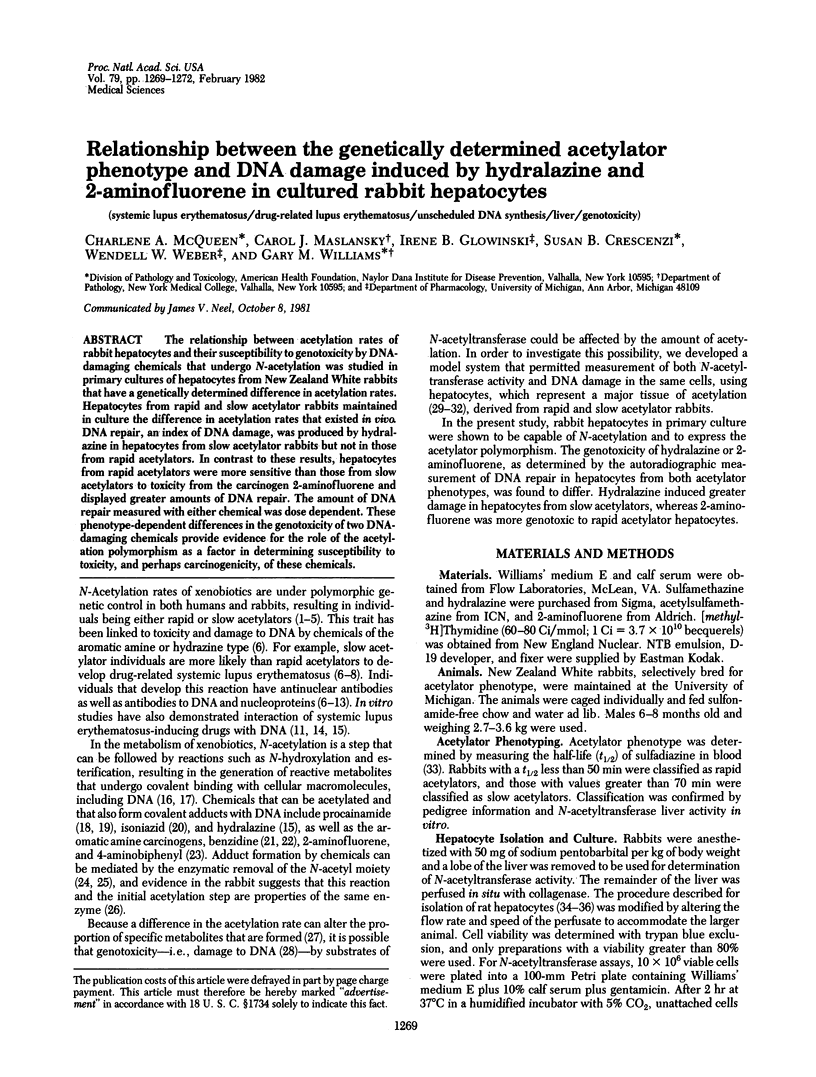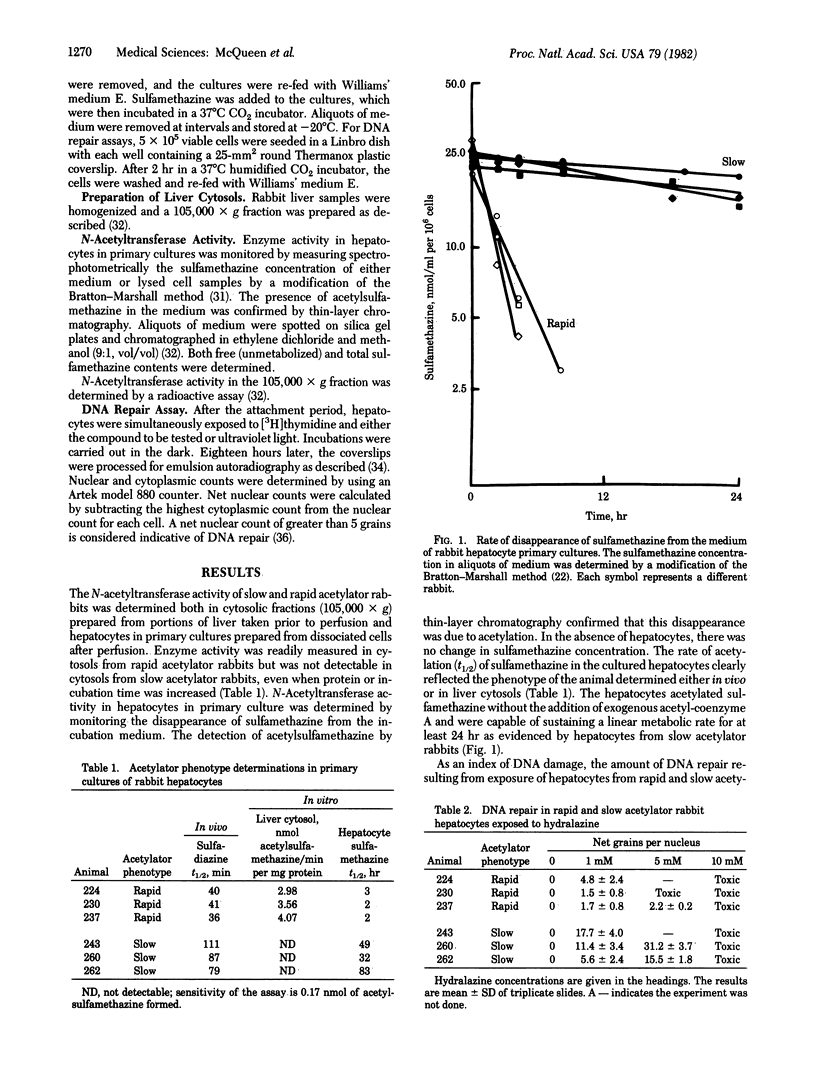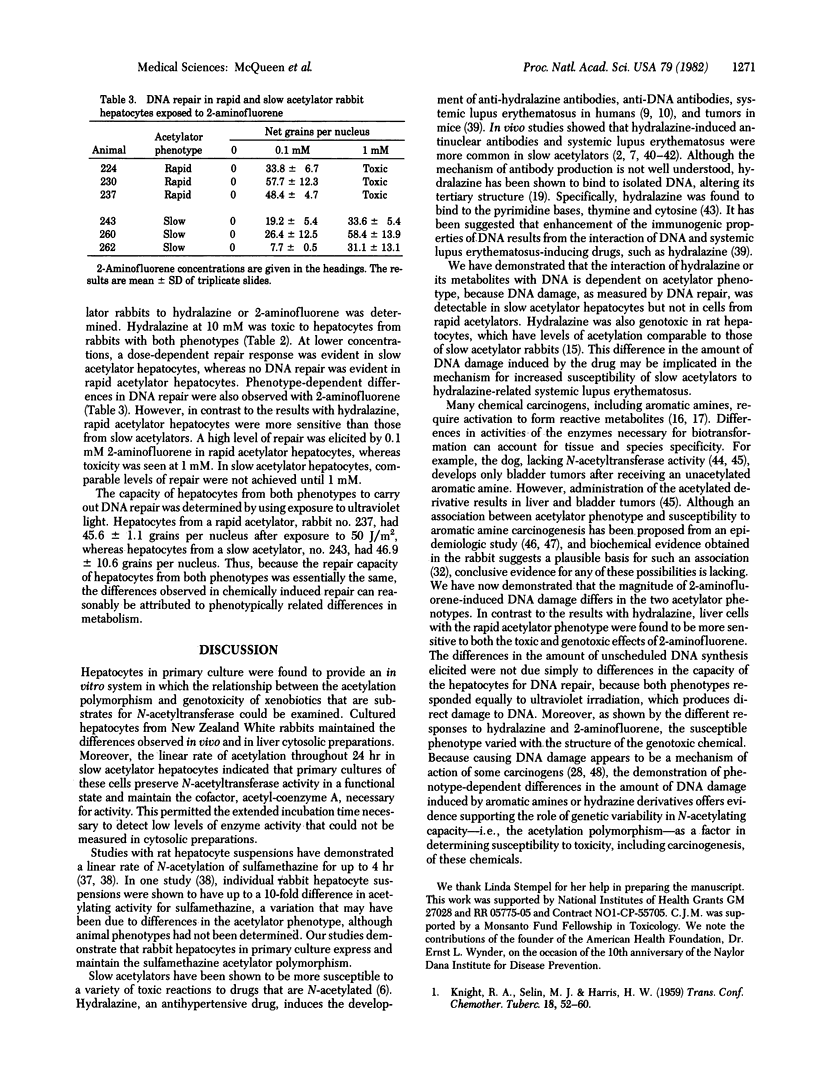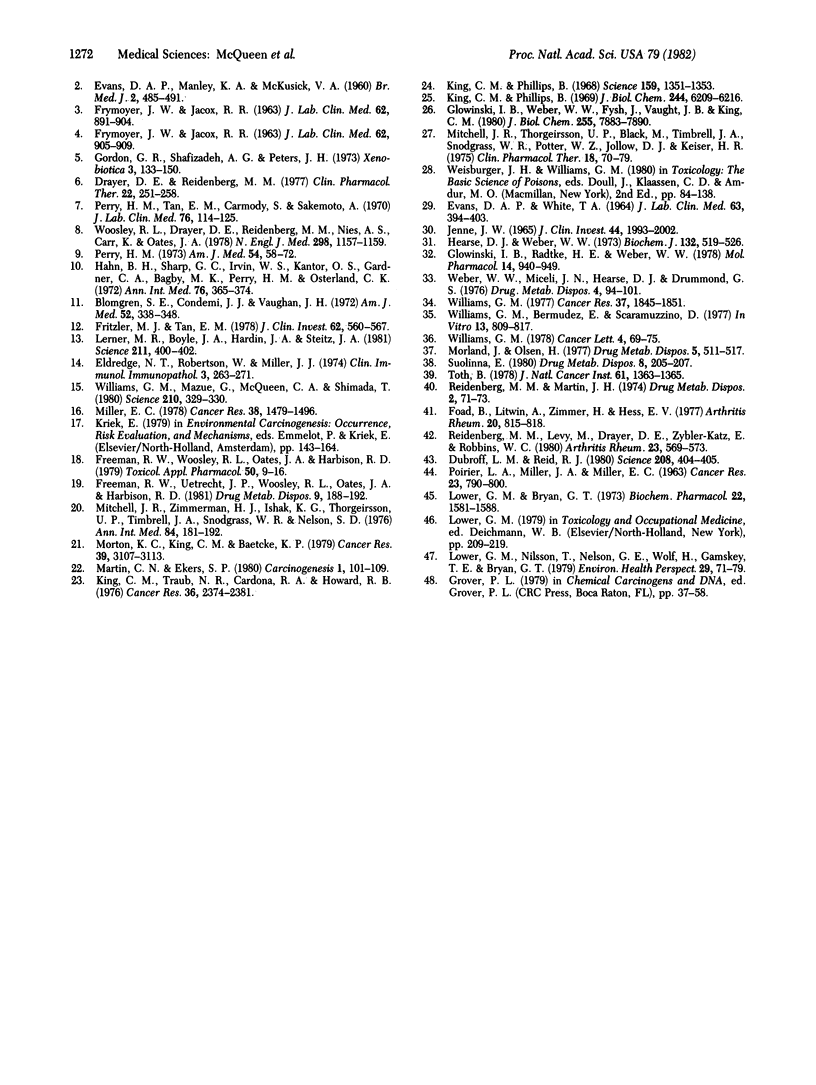Abstract
The relationship between acetylation rates of rabbit hepatocytes and their susceptibility to genotoxicity by DNA-damaging chemicals that undergo N-acetylation was studied in primary cultures of hepatocytes from New Zealand White rabbits that have a genetically determined difference in acetylation rates. Hepatocytes from rapid and slow acetylator rabbits maintained in culture the difference in acetylation rates that existed in vivo, DNA repair, an index of DNA damage, was produced by hydralazine in hepatocytes from slow acetylator rabbits but not in those from rapid acetylators. In contrast to these results, hepatocytes from rapid acetylators were more sensitive than those from slow acetylators to toxicity from the carcinogen 2-aminofluorene and displayed greater amounts of DNA repair. The amount of DNA repair measured with either chemical was dose dependent. These phenotype-dependent differences in the genotoxicity of two DNA-damaging chemicals provide evidence for the role of the acetylation polymorphism as a factor in determining susceptibility to toxicity, and perhaps carcinogenicity, of these chemicals.
Full text
PDF



Selected References
These references are in PubMed. This may not be the complete list of references from this article.
- Blomgren S. E., Condemi J. J., Vaughan J. H. Procainamide-induced lupus erythematosus. Clinical and laboratory observations. Am J Med. 1972 Mar;52(3):338–348. doi: 10.1016/0002-9343(72)90021-6. [DOI] [PubMed] [Google Scholar]
- Drayer D. E., Reidenberg M. M. Clinical consequences of polymorphic acetylation of basic drugs. Clin Pharmacol Ther. 1977 Sep;22(3):251–258. doi: 10.1002/cpt1977223251. [DOI] [PubMed] [Google Scholar]
- Dubroff L. M., Reid R. J., Jr Hydralazine-pyrimidine interactions may explain hydralazine-induced lupus erythematosus. Science. 1980 Apr 25;208(4442):404–406. doi: 10.1126/science.7367866. [DOI] [PubMed] [Google Scholar]
- EVANS D. A., MANLEY K. A., McKUSICK V. A. Genetic control of isoniazid metabolism in man. Br Med J. 1960 Aug 13;2(5197):485–491. doi: 10.1136/bmj.2.5197.485. [DOI] [PMC free article] [PubMed] [Google Scholar]
- EVANS D. A., WHITE T. A. HUMAN ACETYLATION POLYMORPHISM. J Lab Clin Med. 1964 Mar;63:394–403. [PubMed] [Google Scholar]
- Eldredge N. T., van Robertson W. B., Jiller J. J., 3rd The interaction of lupus-inducing drugs with deoxyribonucleic acid. Clin Immunol Immunopathol. 1974 Nov;3(2):262–271. doi: 10.1016/0090-1229(74)90014-2. [DOI] [PubMed] [Google Scholar]
- FRYMOYER J. W., JACOX R. F. INVESTIGATION OF THE GENETIC CONTROL OF SULFADIAZINE AND ISONIAZID METABOLISM IN THE RABBIT. J Lab Clin Med. 1963 Dec;62:891–904. [PubMed] [Google Scholar]
- FRYMOYER J. W., JACOX R. F. STUDIES OF GENETICALLY CONTROLLED SULFADIAZINE ACETYLATION IN RABBIT LIVERS: POSSIBLE IDENTIFICATION OF THE HETEROZYGOUS TRAIT. J Lab Clin Med. 1963 Dec;62:905–909. [PubMed] [Google Scholar]
- Foad B., Litwin A., Zimmer H., Hess E. V. Acetylator phenotype in systemic lupus erythematosus. Arthritis Rheum. 1977 Apr;20(3):815–818. doi: 10.1002/art.1780200309. [DOI] [PubMed] [Google Scholar]
- Freeman R. W., Uetrecht J. P., Woosley R. L., Oates J. A., Harbison R. D. Covalent binding of procainamide in vitro and in vivo to hepatic protein in mice. Drug Metab Dispos. 1981 May-Jun;9(3):188–192. [PubMed] [Google Scholar]
- Freeman R. W., Woosley R. L., Oates J. A., Harbison R. D. Evidence for the biotransformation of procainamide to a reactive metabolite. Toxicol Appl Pharmacol. 1979 Aug;50(1):9–16. doi: 10.1016/0041-008x(79)90486-1. [DOI] [PubMed] [Google Scholar]
- Fritzler M. J., Tan E. M. Antibodies to histones in drug-induced and idiopathic lupus erythematosus. J Clin Invest. 1978 Sep;62(3):560–567. doi: 10.1172/JCI109161. [DOI] [PMC free article] [PubMed] [Google Scholar]
- Glowinski I. B., Radtke H. E., Weber W. W. Genetic variation in N-acetylation of carcinogenic arylamines by human and rabbit liver. Mol Pharmacol. 1978 Sep;14(5):940–949. [PubMed] [Google Scholar]
- Glowinski I. B., Weber W. W., Fysh J. M., Vaught J. B., King C. M. Evidence that arylhydroxamic acid N,O-acyltransferase and the genetically polymorphic N-acetyltransferase are properties of the same enzyme in rabbit liver. J Biol Chem. 1980 Aug 25;255(16):7883–7890. [PubMed] [Google Scholar]
- Gordon G. R., Shafizadeh A. G., Peters J. H. Polymorphic acetylation of drugs in rabbits. Xenobiotica. 1973 Mar;3(3):133–150. doi: 10.3109/00498257309151508. [DOI] [PubMed] [Google Scholar]
- Hahn B. H., Sharp G. C., Irvin W. S., Kantor O. S., Gardner C. A., Bagby M. K., Perry H. M., Jr, Osterland C. K. Immune responses to hydralazine and nuclear antigens in hydralazine-induced lupus erythematosus. Ann Intern Med. 1972 Mar;76(3):365–374. doi: 10.7326/0003-4819-76-3-365. [DOI] [PubMed] [Google Scholar]
- Hearse D. J., Weber W. W. Multiple N-acetyltransferases and drug metabolism. Tissue distribution, characterization and significance of mammalian N-acetyltransferase. Biochem J. 1973 Mar;132(3):519–526. doi: 10.1042/bj1320519. [DOI] [PMC free article] [PubMed] [Google Scholar]
- King C. M., Phillips B. Enzyme-catalyzed reactions of the carcinogen N-hydroxy-2-fluorenylacetamide with nucleic acid. Science. 1968 Mar 22;159(3821):1351–1353. doi: 10.1126/science.159.3821.1351. [DOI] [PubMed] [Google Scholar]
- King C. M., Phillips B. N-hydroxy-2-fluorenylacetamide. Reaction of the carcinogen with guanosine, ribonucleic acid, deoxyribonucleic acid, and protein following enzymatic deacetylation or esterification. J Biol Chem. 1969 Nov 25;244(22):6209–6216. [PubMed] [Google Scholar]
- King C. M., Traub N. R., Cardona R. A., Howard R. B. Comparative adduct formation of 4-aminobiphenyl and 2-aminofluorene derivatives with macromolecules of isolated liver parenchymal cells. Cancer Res. 1976 Jul;36(7 Pt 1):2374–2381. [PubMed] [Google Scholar]
- Lerner M. R., Boyle J. A., Hardin J. A., Steitz J. A. Two novel classes of small ribonucleoproteins detected by antibodies associated with lupus erythematosus. Science. 1981 Jan 23;211(4480):400–402. doi: 10.1126/science.6164096. [DOI] [PubMed] [Google Scholar]
- Lower G. M., Jr, Bryan G. T. Enzymatic N-acetylation of carcinogenic aromatic amines by liver cytosol of species displaying different organ susceptibilities. Biochem Pharmacol. 1973 Jul 1;22(13):1581–1588. doi: 10.1016/0006-2952(73)90024-5. [DOI] [PubMed] [Google Scholar]
- Lower G. M., Jr, Nilsson T., Nelson C. E., Wolf H., Gamsky T. E., Bryan G. T. N-acetyltransferase phenotype and risk in urinary bladder cancer: approaches in molecular epidemiology. Preliminary results in Sweden and Denmark. Environ Health Perspect. 1979 Apr;29:71–79. doi: 10.1289/ehp.792971. [DOI] [PMC free article] [PubMed] [Google Scholar]
- Miller E. C. Some current perspectives on chemical carcinogenesis in humans and experimental animals: Presidential Address. Cancer Res. 1978 Jun;38(6):1479–1496. [PubMed] [Google Scholar]
- Mitchell J. R., Thorgeirsson U. P., Black M., Timbrell J. A., Snodgrass W. R., Potter W. Z., Jollow H. R., Keiser H. R. Increased incidence of isoniazid hepatitis in rapid acetylators: possible relation to hydranize metabolites. Clin Pharmacol Ther. 1975 Jul;18(1):70–79. doi: 10.1002/cpt197518170. [DOI] [PubMed] [Google Scholar]
- Mitchell J. R., Zimmerman H. J., Ishak K. G., Thorgeirsson U. P., Timbrell J. A., Snodgrass W. R., Nelson S. D. Isoniazid liver injury: clinical spectrum, pathology, and probable pathogenesis. Ann Intern Med. 1976 Feb;84(2):181–192. doi: 10.7326/0003-4819-84-2-181. [DOI] [PubMed] [Google Scholar]
- Morland J., Olsen H. Metabolism of sulfadimidine, sulfanilamide, p-aminobenzoic acid, and isoniazid in suspensions of parenchymal and nonparenchymal rat liver cells. Drug Metab Dispos. 1977 Nov-Dec;5(6):511–517. [PubMed] [Google Scholar]
- Morton K. C., King C. M., Baetcke K. P. Metabolism of benzidine to N-hydroxy-N,N'-diacetylbenzidine and subsequent nucleic acid binding and mutagenicity. Cancer Res. 1979 Aug;39(8):3107–3113. [PubMed] [Google Scholar]
- POIRIER L. A., MILLER J. A., MILLER E. C. The N- and ring-hydroxylation of 2-acetylaminofluorene and the failure to detect N-acetylation of 2-aminofluorene in the dog. Cancer Res. 1963 Jun;23:790–800. [PubMed] [Google Scholar]
- Perry H. M., Jr Late toxicity to hydralazine resembling systemic lupus erythematosus or rheumatoid arthritis. Am J Med. 1973 Jan;54(1):58–72. doi: 10.1016/0002-9343(73)90084-3. [DOI] [PubMed] [Google Scholar]
- Perry H. M., Jr, Tan E. M., Carmody S., Sakamoto A. Relationship of acetyl transferase activity to antinuclear antibodies and toxic symptoms in hypertensive patients treated with hydralazine. J Lab Clin Med. 1970 Jul;76(1):114–125. [PubMed] [Google Scholar]
- Reidenberg M. M., Levy M., Drayer D. E., Zylber-Katz E., Robbins W. C. Acetylator phenotype in idiopathic systemic lupus erythematosus. Arthritis Rheum. 1980 May;23(5):569–573. doi: 10.1002/art.1780230508. [DOI] [PubMed] [Google Scholar]
- Reidenberg M. M., Martin J. H. The acetylator phenotype of patients with systemic lupus erythematosus. Drug Metab Dispos. 1974 Jan-Feb;2(1):71–73. [PubMed] [Google Scholar]
- Suolinna E. M. Metabolism of sulfanilamide and related drugs in isolated rat and rabbit liver cells. Drug Metab Dispos. 1980 Jul-Aug;8(4):205–207. [PubMed] [Google Scholar]
- Toth B. Tumorigenic effect of 1-hydrazinophthalazine hydrochloride in mice. J Natl Cancer Inst. 1978 Nov;61(5):1363–1365. doi: 10.1093/jnci/61.5.1363. [DOI] [PubMed] [Google Scholar]
- Weber W. W., Miceli J. N., Hearse D. J., Drummond G. S. N-acetylation of drugs. Pharmacogenetic studies in rabbits selected for their acetylator characteristics. Drug Metab Dispos. 1976 Jan-Feb;4(1):94–101. [PubMed] [Google Scholar]
- Williams G. M., Bermudez E., Scaramuzzino D. Rat hepatocyte primary cell cultures. III. Improved dissociation and attachment techniques and the enhancement of survival by culture medium. In Vitro. 1977;13(12):809–817. doi: 10.1007/BF02615128. [DOI] [PubMed] [Google Scholar]
- Williams G. M. Detection of chemical carcinogens by unscheduled DNA synthesis in rat liver primary cell cultures. Cancer Res. 1977 Jun;37(6):1845–1851. [PubMed] [Google Scholar]
- Williams G. M. Further improvements in the hepatocyte primary culture DNA repair test for carcinogens: detection of carcinogenic biphenyl derivatives. Cancer Lett. 1978 Feb;4(2):69–75. doi: 10.1016/s0304-3835(78)93522-x. [DOI] [PubMed] [Google Scholar]
- Williams G. M., Mazue G., McQueen C. A., Shimada T. Genotoxicity of the antihypertensive drugs hydralazine and dihydralazine. Science. 1980 Oct 17;210(4467):329–330. doi: 10.1126/science.7423193. [DOI] [PubMed] [Google Scholar]
- Woosley R. L., Drayer D. E., Reidenberg M. M., Nies A. S., Carr K., Oates J. A. Effect of acetylator phenotype on the rate at which procainamide induces antinuclear antibodies and the lupus syndrome. N Engl J Med. 1978 May 25;298(21):1157–1159. doi: 10.1056/NEJM197805252982101. [DOI] [PubMed] [Google Scholar]


